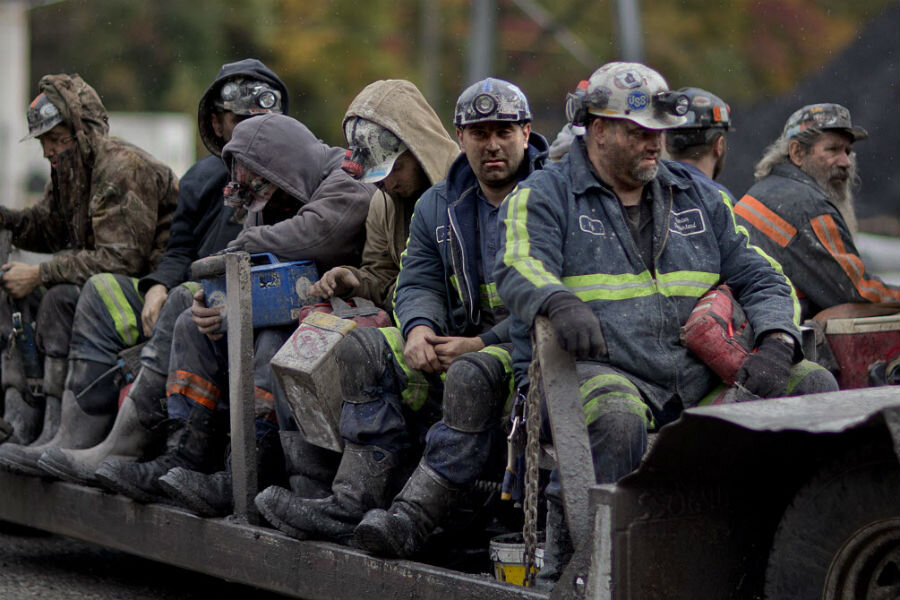Safety-first culture drives record low coal-mine fatalities
Loading...
Less than five years after a deadly explosion in a West Virginia coal mine killed 29 men, the coal mining industry appears to be gaining ground in mine safety.
Since that tragic April day, the mining industry and federal regulators doubled down efforts to institutionalize safety and improve safety records. In 2014, coal mine-related fatalities hit a record low. So far this year, 16 people died in coal mining-related accidents, ducking under the previous low of 18 workers set in 2009. That’s a major improvement over the 48 deaths seen in 2010, the year of the Upper Big Branch coal mine explosion in West Virginia.
In the wake of that disaster, the US Mine Safety and Health Administration (MSHA), a division of the US Labor Department, launched an aggressive inspection campaign designed to root out systemic failings and cultures that placed production over safety. Shortly after the explosion, the safety agency issued a priority list of 42 coal mines with patterns of safety violations to investigate. Since then, the number of coal mines on that list has dwindled to six.
The decline in fatalities has been partially fueled by a reduction in the number of underground mines under production in Appalachia as market favorability has declined in response to climate change and the natural gas boom.
While regulatory efforts have contributed to the decline in coal mine worker fatalities, much of the credit belongs to the miners and mining companies, says Steven Sandbrook, a mine safety consultant for Eagle Mine Safety in Nazareth, Pa.
“Not enough credit is given to the men and women who work in the industry and the corporations who employ those men and women and do understand that lives matter and that the coal cannot be produced without its most precious resource, which is the American miner,” Mr. Sandbrook says.
The majority of mine accidents happen because of split-second decisions made by individual miners, Sandbrook says. However, those decisions are influenced by the culture of the mining company, he says. If a company places profit above safety as a core value, that prioritization trickles down into the mine shafts and can lead to shortcuts and unnecessary risks, he says.
MSHA cited corporate culture as the root cause of the West Virginia explosion on April 5, 2010. The Upper Big Branch Mine was operated by Performance Coal Co., a subsidiary of Massey Energy Co. MSHA’s investigation of the disaster concluded that PCC and Massey Energy “promoted and enforced a workplace culture that valued production over safety, including practices calculated to allow it to conduct mining operations in violation of the law.”
In 2011, MSHA levied a $10.8 million fine, the largest in agency history, against Massey Energy. In November 2014, former Massey chief executive Don Blankenship was indicted on federal charges of conspiring to willfully violate ventilation and coal dust rules, meant to protect miners’ lungs and to prevent explosions. Mr. Blankenship could face a maximum of 31 years in prison.
MSHA Director and Assistant Labor Secretary Joseph Main lauds one company, Virginia-based Alpha Natural Resources, for leading the way in mine safety by employing innovative safety protocols that focus heavily on collaboration with workers.
Alpha’s “Running Right” signature operating philosophy encourages employees to speak up when they see a safety issue and to suggest ways to improve workplace safety, Alpha spokesman Steve Hawkins said in an e-mail to the Monitor.
The company has also invested approximately $23 million in a mine safety training facility and curriculum that has educated 31,000 mine workers, Mr. Hawkins said.
That kind of institutional investment goes a long way toward establishing a safety-first culture, Sandbrook says.
Globally, the United States has emerged as a leader in developing safety and rescue innovations, Sandbrook says. The US regulatory guidelines set by MSHA are some of the most comprehensive in the world, though Sandbrook says he would like to see an additional layer of specificity and consistency akin to those established for other workplaces by the MSHA’s sister agency, the Occupational Safety and Health Administration.
However, no matter how thoroughly and properly executed safety protocols are, mining remains a highly dangerous industry. Cave-ins such as the Chilean mining accident that trapped 33 men underground for 69 days in 2010 can happen anywhere, Sandbrook says.
“When you start moving portions of Mother Earth, if she wants to give she’s going to give. There’s nothing that man’s going to be able to do to stop that, even with the best engineering designs,” Sandbrook says.
“I know that sounds pretty lame, but what I look at is how many days we can go without a collapse, and that tells me we’re doing a pretty darn good job, not only here in the United States but also internationally,” he says.








